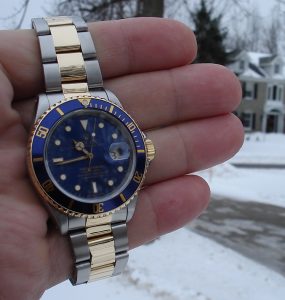As Rolex never stopped the process of refining and improving their watches, some of the areas in which we have seen the vast advancements are the new materials that are being made for use in their replica watches. 
From scratch-proof ceramic bezels to ferromagnetic alloy movement components, contemporary Rolex fake watches utilize some of the most advanced materials on this planet to aid in the company’s ongoing pursuit of building the best mechanical wristwatches possible. However, despite all of the unique, proprietary machines and materials that get used at the Rolex factory in Geneva, one of the most interesting factors of the Rolex production process is the type of stainless steel that is used for the cases and bracelets of their watches.
Most timepiece manufacturers use 316L stainless steel, which is more than adequate for the vast majority of applications and environments one is likely to encounter in everyday life. However, Rolex chooses to use a unique blend of 904L stainless steel for their watches, known as “Oystersteel” that is resistant to several different forms of corrosion. However, no distinction was made between the two metals, so it is highly likely that “Oystersteel” is just Rolex’s name for the high-quality, 904L stainless steel that is produced by their in-house foundry.
904L stainless steel is a low-carbon variety of stainless steel with additives of nickel, chromium, copper, and molybdenum to make it highly resistant to the vast majority of different types of corrosion. Most commonly used in the aerospace and chemical industries, 904L is difficult to shape and often requires the use of specialized equipment to properly cut and machine. Even though it is more expensive and difficult to use, 904L can take on a higher polish than traditional stainless steel alloys and possess several anti-corrosive properties that are somewhat similar to those of precious metals.
When they became the first wristwatch manufacturer to use it on a large scale in their timepieces, Rolex’s use of 904L stainless steel dates all the way back to 1985. Initially, during the late 1980s, 904L stainless steel was only used for the replica Rolex Sea-Dweller line of deep-sea diving watches; however, in 2003, the Rolex replica switched all of their lines of watches over to 904L stainless steel, thanks to the superior corrosion resistance that is offered.
Rolex found that stainless steel watches exhibited more premature wear on their case-back threads than what was observed on their precious metal counterparts, and so the decision was made to switch to 904L stainless steel for all of their lines of watches.
Even though the “Oystersteel” is likely just another name for the 904L stainless steel manufactured by Rolex’s in-house foundry, it is undeniable that 904L stainless steel gives additional benefits over most traditionally used stainless steel varieties. Whether it is called “Oystersteel” or 904L stainless steel, this highly durable, corrosion-resistant metal is part of what defines a contemporary replica Rolex.